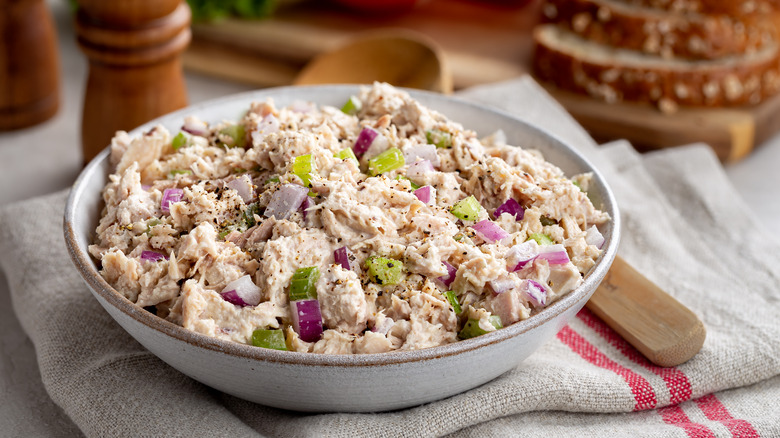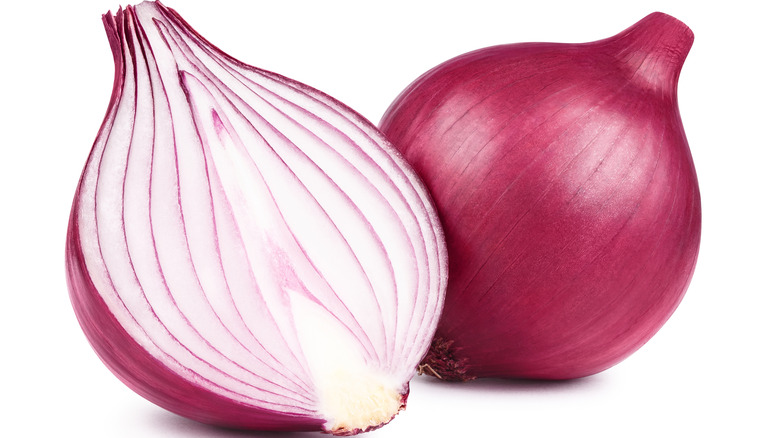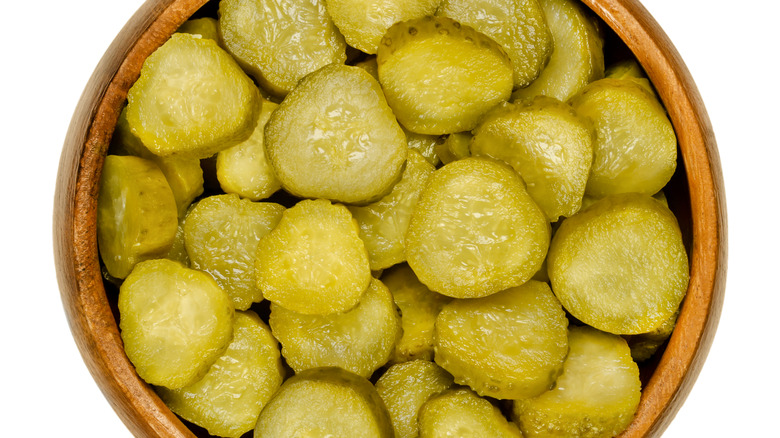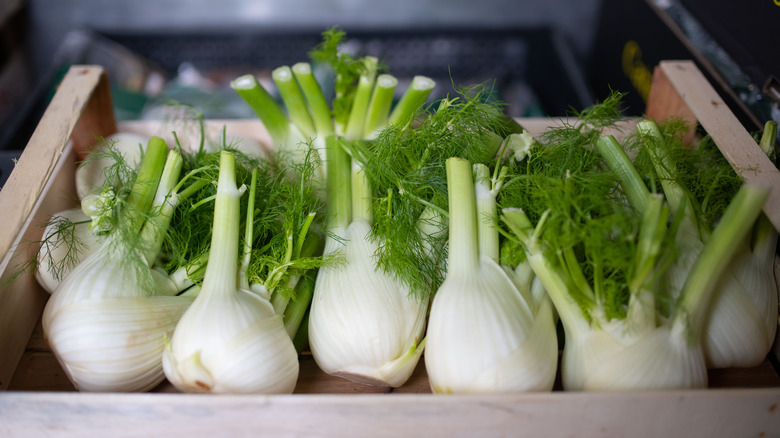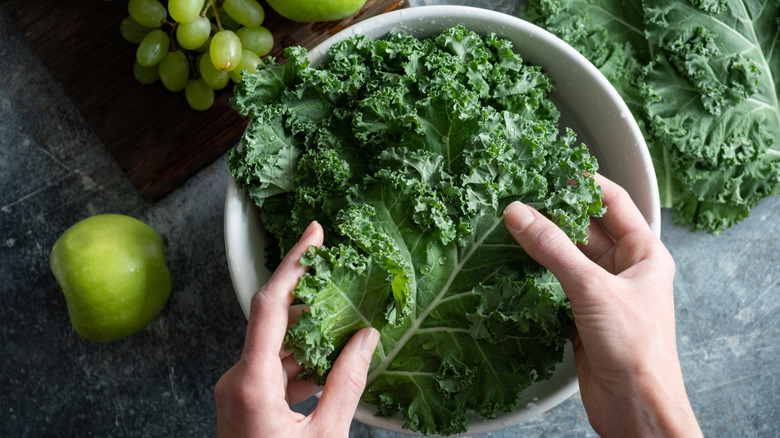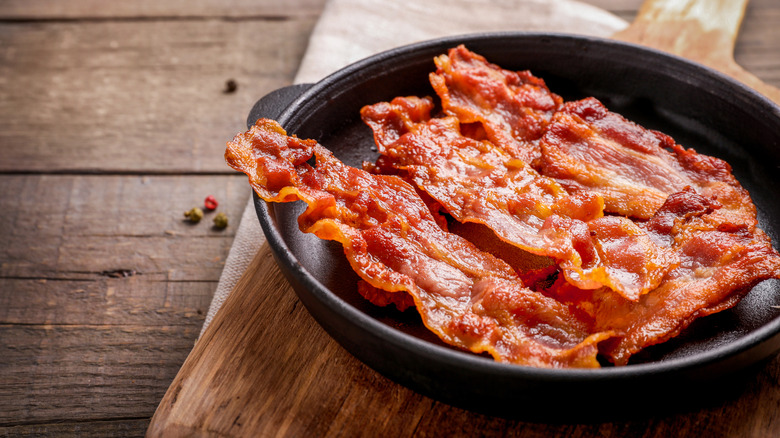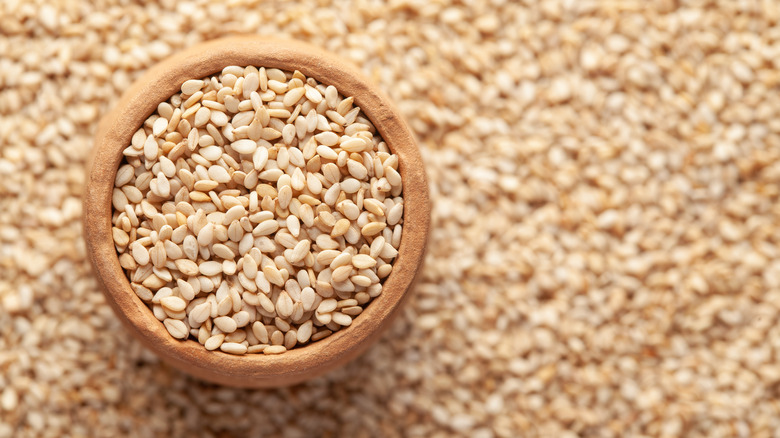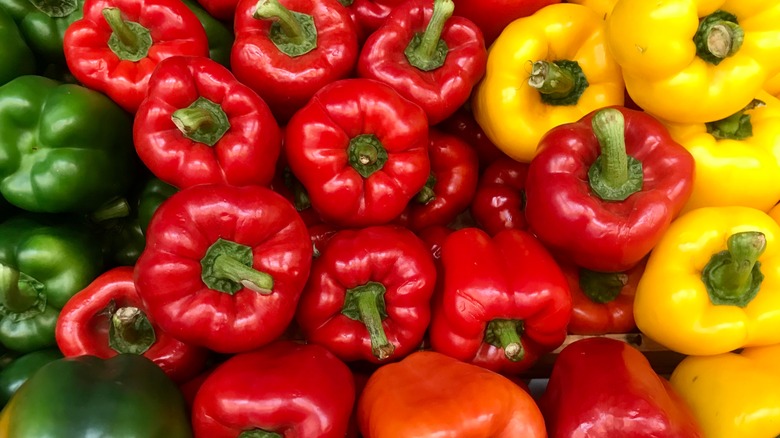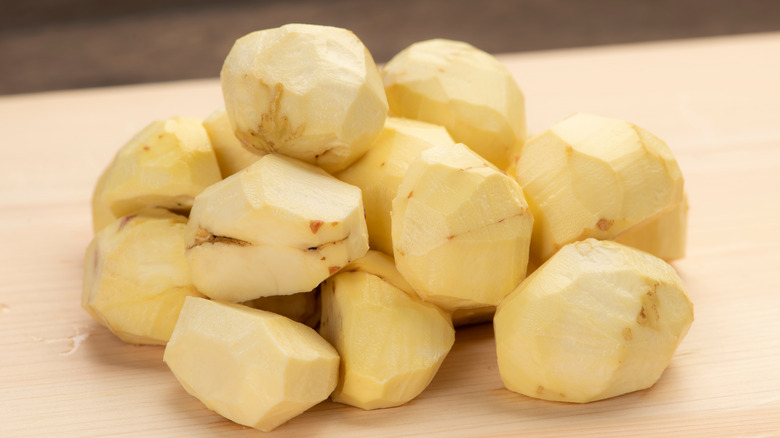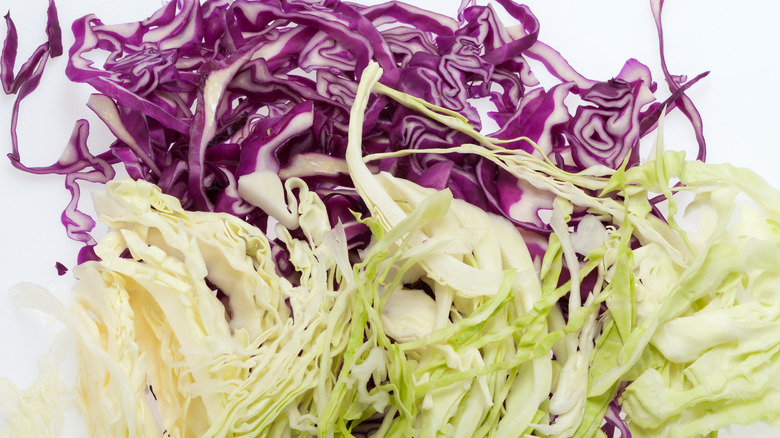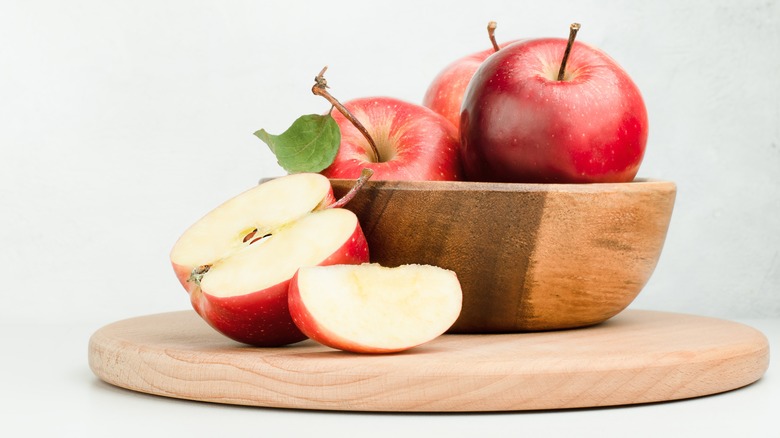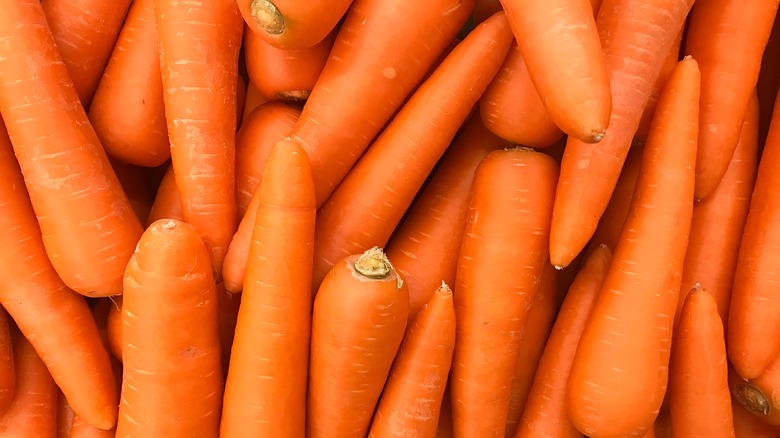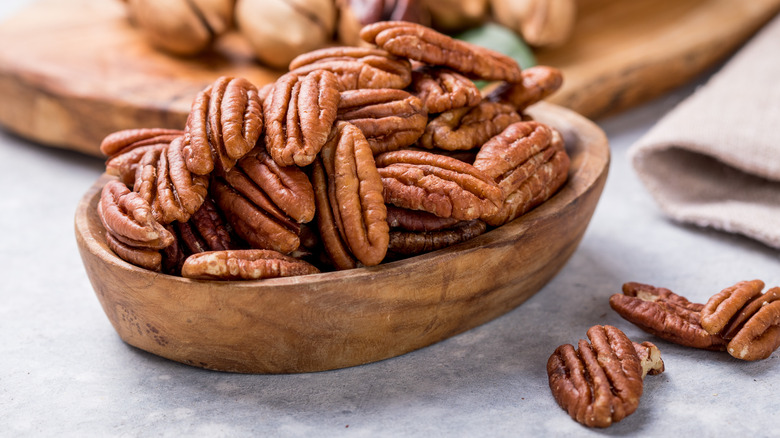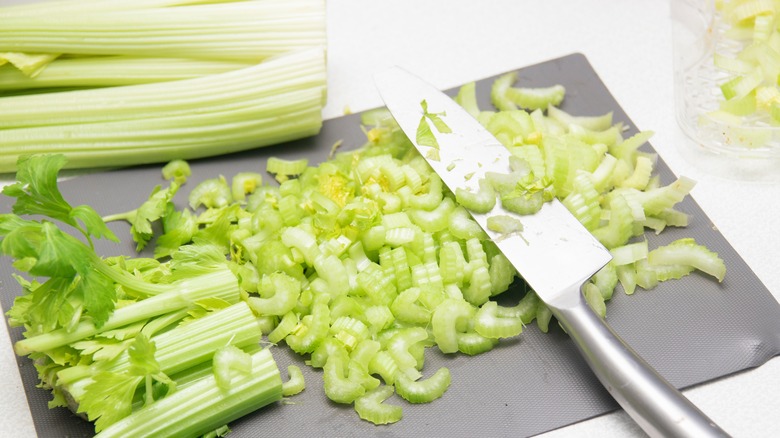13 Mix-Ins To Add Crunch To Your Tuna Salad
Tuna salad is one of those deli staples that's so easy to whip up at home. It's creamy, satisfying, and perfect on a bed of greens or between thick slices of whole-grain bread. According to the Smithsonian, the dish is an evolution of frugal housekeeping practices. The fish scraps from the previous night's dinner would be mixed with vegetables, relishes, and mayonnaise and eaten for lunch on beds of greens.
Even though tuna salad started as a mishmash of leftovers, it's now specifically made as a starring midday meal. Between the flaky fish and the creamy mayo, you'll want to add something to give your sandwich a nice crunch. Luckily, there are plenty of options to add a bit of tooth to the dish. Since it's such a flexible recipe (the only two non-negotiables being the fish and the mayo), it opens up many possibilities for ingredients to add crunch to its texture. Whether you want to add additional flavor dimensions or keep things simple, you can easily improve your tuna salad game.
Red onions
Red onion is a triple threat when it comes to being a mix-in: it adds flavor, crunch, and color. You can't go wrong by dicing half of one and adding it to your tuna salad early on. The taste of the root vegetable will steep into the dish the longer it's combined while keeping its crunchy texture.
Red onion is often the top choice among other varieties because it tends to be milder in flavor when raw than standard yellow onions. Plus, its vibrant color adds a pleasant pop to the overall appearance of tuna salad. They also pickle very nicely, becoming a vivid pink when allowed to soak briefly in vinegar.
If these veggies have too much bite for you, you could opt for shallots, which are also a rosy shade but have a slightly sweeter taste. Chives and scallions, deep green and equally mild in flavor, could be used if you want that note of onion and the contrasting color, but they won't offer quite as much crunch. Sweet onions, like Vidalias or Mauis, provide a crisp, sweeter taste but won't be as visually striking.
Pickles
Why are pickles so addictive? Is it the vinegar? The dill? The cold crunch? Who knows? The fermented veggie is delicious and brings its own vibe to a dish when you add it. Relishes were one of the original ingredients added to the early versions of tuna salad. And sure, you could use a jar of it to step up your tuna game, but freshly chopped pickles will really make your sandwich shine.
There are lots of different pickle varieties, depending on the spices and flavors that they're, well, pickled in. Bread and butter, dill, and gherkins are just a few you're probably familiar with. However, it doesn't really matter what type you use to add some jazz to your tuna salad as long as you enjoy the flavor. The vinegar compliments the creamy mayo, and the crunchy cucumber is perfect with the flaky fish.
And cucumbers aren't the only pickled veggie you could use to add a tangy snap to your meal. Fermented onions, peppers, and cauliflower are also delightful options that can be chopped up and tossed with your tuna salad.
Fennel
Fennel is one of those unique-looking vegetables you might bypass in the grocery store because you have no idea what to do with it. Its feathery fronds and crunchy bulbous body might remind you of a cross between an onion and a celery stalk. However, its flavor is actually very bright, botanical, and a bit like licorice.
The texture of the veggie is perfect for adding to tuna salad because it can be sliced very thin while maintaining its crunch. When asked how one might dress up canned seafood for a party, Chef Tom Colicchio recommended slicing fresh fennel on a mandolin to get it paper thin before adding it to tuna. Its herbaceous flavor is a departure from the norm, adding a bit of bitterness and the botanical licorice essence. It's definitely a surefire way to make your tuna salad stand out if you plan on serving it to a crowd.
The beautiful, feathery fronds of the fennel can also be used as a garnish or mix-in. Their dark green coloring provides a gorgeous contrast in hue and brings a bright, bitter note to cut through the creaminess of the mayonnaise.
Kale stems
Kale is a superfood, without a doubt; it is loaded with vitamins and nutrients and is a winning ingredient when it comes to salads. However, it's important to prepare this leafy green correctly to make your meal an enjoyable experience, and that includes removing the fibrous center stem that runs through the center.
In the spirit of the waste-not-want-not origin of tuna salad, the stems of the kale leaves can be chopped up and mixed into the dish. Though they're hard to chew and digest when whole, they can offer a nice crunch if diced finely. It's a perfect method of integrating the leafy green into your meal and getting the most benefit.
Kale stems can also be pickled, then sliced up to bring in that tangy, fermented flavor that really wakes up a creamy tuna salad. So don't toss those stems; just fold them right on in.
Bacon
The internet's obsession with bacon may have waned a bit in the last decade, but there's no denying that it is an amazing addition to any dish. Smoky, salty, and savory, it brings a lot of notes to the table.
When you cook the bacon, save the grease. It's liquid gold and adds amazing flavor when you use it as fat to cook down things like onions or mushrooms. You can also use it to make an amazing tuna melt! Once you've chopped up the bacon and added it to your mix, you can fry up your creation in the flavorful fat to really make your toasted tuna sandwich an exercise in decadence.
You can use standard pork or turkey bacon; either one will give you the smoky crunch you want. Mix the crumbles into the tuna salad directly or sprinkle it on top. There's really no wrong way to add bacon to a meal, is there?
Toasted sesame seeds
You might be familiar with sesame seeds as a garnish on crackers and burger buns. Sesame oil and tahini are also popular ingredients, with a flavor profile often appearing in Middle Eastern and Asian cuisines.
Sesame seeds have a pleasant nutty flavor, especially when toasted. They also pack a good amount of nutrition: According to Healthline, they provide a lot of fiber and protein. They also have B vitamins, antioxidants, and key minerals such as manganese and zinc. Such a shame that they've been relegated to a garnish!
Give your tuna salad a nutrient boost by toasting up some sesame seeds and stirring them into the prepared dish. Toasting essentially wakes up the oils in the ingredient, bringing the nutty flavor to the forefront. It will also make the pieces slightly pop when you crunch into them, adding a fun texture to your otherwise soft tuna salad.
Peppers
There are so many different kinds of peppers out there. Adding some to your lunch can be a sweet or scalding experience, depending on your preference. But both options have their charms! Peppers can be a colorful and flavorful add-in to your tuna salad, providing lots of crunch and a healthy dose of nutrients. According to WebMD, peppers contain high amounts of vitamins C and A, potassium, and folic acid. So adding a cup of chopped peppers not only brings texture and flavor, it will boost the nutritional value of your meal.
Sweet bell peppers are a cool, crunchy addition. They come in a rainbow of colors, and their sweetness level will vary depending on which variety you choose. Green capsicums tend to be slightly more bitter than their red siblings, with yellow and orange falling in the middle of the spectrum. Jalapeños, on the other hand, are going to pack more of the heat; whether they're pickled or fresh, they contain more capsaicin, the source of the spice. They add crunch while also making tuna salad spicier.
You can experiment with the different varieties of peppers, going up the Scoville scale, if you want to introduce more heat.
Water chestnuts
Water chestnuts are ingredients that often appear in stir-fries and Asian cuisine and can be purchased canned from the international section of the grocery store. However, most people might be hard-pressed to really define the produce. So what are they?
Water chestnuts are actually not nuts but rather tubers, similar to jicama. Their name comes from the fact that they look like knobby, dark nuts in their natural, unpeeled state. However, their flesh is crisp in texture. They contain a healthy amount of antioxidants, B vitamins, and filling nutritional fiber. So they are a beneficial addition to tuna salad, giving it crunch and bulk.
Taste-wise, water chestnuts are incredibly mild. Slightly sweet and earthy, the aquatic vegetables do a great job absorbing the flavors around them. Dicing them up finely will provide a snappy texture to your tuna salad without overshadowing any other ingredients you might be adding.
Red or green cabbage
Cabbage can be a divisive vegetable. While it is the main component of the old picnic staple, cole slaw, it also emits a sulfuric smell when cut and cooked, which many people find objectionable. However, when it's raw, red and green cabbage can be quite mild and bring a very pleasing crunch to the foods it's added to.
According to Healthline, the cruciferous vegetable is a nutritional powerhouse. It contains large amounts of vitamins C and K and folates. It's also loaded with insoluble fiber, which aids in digestion and promotes positive overall gut health. Also, that sulfur smell? It's actually believed that the sulfuric properties might have anti-inflammatory effects. So just because it's a little stinky doesn't mean it should be written off.
Thinly sliced cabbage is a boon in tuna salad, either as a mix-in or as a bed on which to serve the dish. You can also use sauerkraut, or fermented cabbage, which has probiotic qualities and a unique tangy flavor. Kimchi is another version of the vegetable that can be added to tuna salad for additional crunch and flavor.
Apples
Sometimes it's a little bit of sweetness that can really improve the experience of a savory dish. Adding fruit is a fantastic way of bringing texture and another taste dimension to tuna salad. The contrast of sugar with the umami flavor of the fish can create a full-spectrum flavor palate.
Martha Stewart adds apples to her tuna salad; she recommends using gala or Macintosh varieties, both of which are firm-fleshed and not too sweet. If you want to go a little more in the tart direction, you can use a Granny Smith. Be sure to peel the apples before dicing and adding them to your dish.
These fruits do tend to go brown very quickly, so if you're adding them to a tuna salad that you'll be serving to guests, be sure to squeeze some lemon juice on the slices to keep them fresh. The liquid will also add a bright, citrus flavor to the meal.
Carrots
Is it even considered a salad if there aren't carrots involved? These root vegetables are sweet, crunchy, and so vibrant. They immediately add visual appeal to your tuna dish by bringing that sunny orange color.
Carrots are chock full of beta carotene, which your body converts into vitamin A, beneficial for your eyesight and immune system (via Healthline). They're also loaded with potassium and B vitamins and contain lycopene, an antioxidant that may have cancer-fighting properties.
The veggie also comes in a rainbow of colors. Orange, yellow, purple, and red are all the gem-toned hues that you can find in the produce aisle. You can use a grater to shred the carrots or dice them finely before mixing them into the tuna salad. They also pickle nicely, so if you want to do a quick pickle with some vinegar and spices on your shredded root vegetables, you can certainly amp up their flavor.
Pecans
Pecans are, arguably, one of the best nuts out there. They pair delightfully with fruits, cheese, and vegetables. They're a little bit sweet, toast up beautifully in the oven or a skillet, and can be candied or salted before being added to a salad.
If you want to bulk up your tuna dish, consider roasting some pecans and giving them a rough chop. Their flavor will go well with any fruit, like apples or dried cranberries, that you may also add to the meal. Nuts retain their crunch and texture even after they've been incorporated into the mix, so if you're making it ahead of time, you can count on pecans holding up when you finally get to enjoy your creation at lunchtime.
If you're going to be eating your tuna as a composed salad, you should take full advantage of the crunchy texture of the nuts by sprinkling them over the top of your dish instead of mixing them in. You can also add some spice by toasting them with a sprinkle of paprika, cayenne, or Cajun spice blend. The oils in the pecans will "wake up" after being heated, and the spices will cling to them, giving them even more oomph.
Celery
Celery is a vegetable that doesn't get the recognition that it deserves. On its own, it is stringy and not particularly flavorful, but it is a component of more dishes than you might initially imagine.
If you want to make your celery a little more tender, it's actually an easy process. All you need to do is run your veggie peeler along the length of the celery stalk and remove the outermost layer of skin. Once you've peeled the outer layer, you'll be left with a crunchy, tender piece that will be much more enjoyable to eat.
No tuna salad is ever fully complete without some chopped celery. You can also wash the leaves of the stalks thoroughly (they tend to be pretty gritty) and use those fronds as garnishes, as well. They are slightly bitter, almost like parsley, and provide an additional crunch factor along with a flavor burst.
